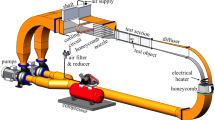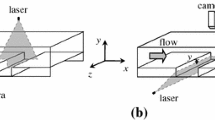Abstract
This paper describes the control of boundary layer on a flat plate by means of cavity flow. In this study, classifying the shapes of cavities into circular arc, rectangle and triangle makes the discussion, and the depths of the cavities are changed systematically. It is made clear, by numerical calculations and experiments, what states of flow are shown in the internal parts of cavities and what kinds of influence are exerted to the boundary layers in the upstream and downstream flows.
As a result, the following facts are made clear. By taking up properly the depth ratios (k/c) of cavities complying with the individual cavity shapes, the boundary layer thickness in the flow upstream and downstream of the cavities can be controlled. Meanwhile with any of the cavities, the existence of the minimum boundary layer thickness (δ/δ m ) min min is seen at a depth ratio.
Similar content being viewed by others
References
Aihara, Y. et al., Applied Aerodynamics, 31-33, University of Tokyo (1991).
Aoki, K. et al., Flow Characteristics of a Golf Ball Using Visualization Techniques, Proceedings of the 1998 World Scientific Congress of Golf, Science and Golf 3 (1998), 446–456.
Choi, D. et al., Application of an RNGκ-ε Model to Compressible Turbulent Shear Layers, AIAA, Paper 94-00188 (1994).
Choi, K.-S., Near-wall structure of a turbulent boundary layer with riblets, J. Fluid Mech, 208(1989), 417–458.
Choi, K.-S. and Fujisawa, N., Possibility of drag reduction using d-type roughness, Applied Scientific Research, 50(1993), 315–324.
Maull, D. J. and East, L. F., Three-dimensional flow in cavities, J. Fluid Mech., 16(1963), 620–632.
Nisimura, T. et al., Flow Patterns and Wall Shear Stresses in Grooved Channels at Intermediate Reynolds Numbers, JSME, 62–598B (1996), 2106–2112.
Okajima, A. et al., Research Institute for Applied Mechanics, Reports, Kyushu University, No.40 (1973), 387–400.
Perry, A. E. et al., Rough wall turbulent boundary layers, J. Fluid Mech., 37(1966), 383–413.
Tani, I. et al., Experimental Investigation of Flow Separation associated with a Step or a Groove, Aero. Res. Inst., Univ. of Tokyo, Report 364(1961), 119–137.
Townes, H. W. and Sabersky, R. H., Experiment on the Flow over a Rough Surface, Int. J. Heat Mass transfer, 9(1966), 729–738.
Yakuhot, V. and Orszag, S. A., Renormalizations Group Analysis of Turbulence, J. Sci. Comput., 1 (1986), 3–51.
Author information
Authors and Affiliations
Additional information
Author Profile Katsumi Aoki: He received his M.Sc.(Eng.) degree in mechanical engineering in 1967 from Tokai University, and his Ph.D. in mechanical engineering in 1986 from the same University. After obtaining M.Sc. he worked as a research assistant, a lecturer, and an associate professor at Tokai University before, taking up his current position as a professor of Tokai University. His current research interests cover flow around a rotating circular cylinder with and without grooves, flow around a rotating sphere, possibility of drag reduction using triangle-type cavity, and flow visualization by spark tracing method of complicated flow field like in centrifugal blower.
Hiroo Okanaga: He received B.Sc.(Eng.) in mechanical engineering in 1985 from Faculty of Science and Technology, Keio University, and his Ph.D. in mechanical engineering in 1990 from the same University. After obtaining Ph.D. he worked as an assistant of Professor Aoki, before taking up his current position as an assistant Professor of the Tokai University. His research interests cover Electrohydrodynamics liquid jets which are produced by applying a high electric voltage between the ring electrode and plate electrode in the liquid as a mixture of R113 and ethanol.
Yasuki Nakayama: He received his B.Sc. (Eng.) degree in mechanical engineering in 1952 from Waseda University, and his Ph.D. in mechanical engineering from the same University in 1963. He joined the National Railway Research Institute and conducted many research investigations in the area of fluid mechanics. He then became a professor of Tokai University, where he taught and researched fluid mechanics and visualization. He later became President of the Future Technology Research Institute. He has received many distinctions and awards for his outstanding research. He has been a visiting professor of Southampton University, UK, President of The Visualization Society of Japan, and Director of the Japan Society of Mechanical Engineers. He has published 10 books and more than 160 research papers.
Rights and permissions
About this article
Cite this article
Aoki, K., Okanaga, H. & Nakayama, Y. Control of boundary layer on a flat plate by means of cavity flow. J Vis 3, 211–220 (2000). https://doi.org/10.1007/BF03181843
Received:
Revised:
Issue Date:
DOI: https://doi.org/10.1007/BF03181843




